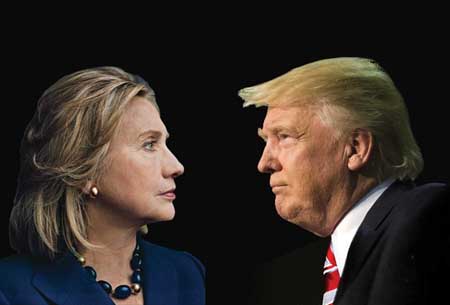
Let’s take a look at where the next Commander-in-Chief of the United States stands on some of the pressing issues of 2016.
Immigration
How the next president deals with the estimated 11.4 million unauthorized immigrants in the U.S. could reshape the country’s demographic, social and economic landscape.
Hillary Clinton
“If we claim we are for family, then we have to pull together and resolve the outstanding issues around our broken immigration system. We can’t wait any longer for a path to full and equal citizenship.” – May 5, 2015
Within her first 100 days in office, Hillary Clinton plans to introduce a comprehensive immigration reform with a pathway to full and equal citizenship that will treat each person with dignity, fix the family visa backlog, protect our borders and national security, and bring millions of hardworking people into the formal economy.
She will end the three-year bar that bans immigrants who overstay their visas by 180 days from reentering the U.S. for three years as well as the 10-year bar, which prohibits immigrants who were in the country illegally for more than one year from reentering the U.S. for 10 years.
She also plans to close private immigrant detention centers and to end family detention for refugee parents and children who arrive at the U.S. border in desperate situations.
Donald Trump
“We are going to do a wall. We’re going to have a big, fat, beautiful door on the wall. We’re going to have people come in, but they’re going to come in legally.” – Oct. 28, 2015
Donald Trump plans to require that financial institutions request identity documents before accounts are opened or transactions made. Included in the proposed regulation is a rule that no unauthorized immigrant may wire money outside of the U.S. unless the alien first provides a document establishing his or her lawful presence in the U.S.
If the regulation were to go into effect, Mexican citizens would cease to receive money transfers from the U.S., most of which come from illegal immigrants, and the Mexican economy would lose approximately $25 billion a year, according to the article “Remittances to Latin America recover – but not to Mexico” by the Pew Research Center. This regulation will only go into effect if the Mexican government refuses to pay for the wall.
Trump claims the wall will cost between $10 to $12 billion, however, a study by The Washington Post estimated the cost of the wall would be closer to $25 billion. And the U.S. government would have to pay about $750 million a year to maintain the wall.
Immigrants will also be granted entry to the U.S. based on their likelihood of success in this country. According to Trump, these new immigration controls will ensure that jobs are offered to American workers first.
Health Care and Social Security
By 2020, the U.S. will begin to spend more on Medicare and Social Security than the programs collect in interest income and taxes. The two programs already account for a rising share of government spending–around 41 percent of federal spending last year, up from 36 percent in 2011. These figures are set to rise over the next two decades due to the aging of the baby-boomers and the resulting decline in the proportion of workers to retirees.
Hillary Clinton
“I won’t cut Social Security… I’ll defend it, and I’ll expand it.” – Feb. 5, 2016
Clinton believes that Social Security must remain what it has always been: a benefit that seniors can count on. She says she will fight any attempts to gamble seniors’ retirement security on the stock market through privatization, the reduction of the annual cost-of-living adjustments and the Republican efforts to raise the retirement age.
She plans to preserve Social Security by asking the wealthiest 1 percent to contribute more by taxing some of their income not currently taken into account by the Social Security system.
Her plans for Medicare are to fight Republican attempts to repeal the Affordable Care Act, oppose Republicans plans to privatize or “phase out” Medicare, expand access to affordable health care to families regardless of immigration status, and fight for health insurance for the lowest income Americans by incentivizing states to expand Medicaid and making enrollment easier.
She will also defend reproductive health care to ensure that all women have access to preventive care, affordable contraception and safe and legal abortion.
Donald Trump
“I want to keep Social Security intact… I’m not going to cut it.” – July 2016.
Trump will preserve Social Security and other health programs by working with Congress to pass and implement a comprehensive tax-reform plan to streamline personal income tax and by lowering the tax rate to 15 percent, which will apply to all business enterprises, not just the largest corporate giants.
He believes that if the economy is able to grow, if the tax base in increased, if capital and jobs are brought back to the U.S. and if direct foreign investment is encouraged, then entitlement programs like Social Security will be stabilized for the time being.
As for Medicaid and Medicare, Trump has said very little.
Minimum Wage
The federal minimum wage has remained at $7.25 an hour since 2009, and bills in Congress to increase it have gained no traction.
Hillary Clinton
“We need to raise the federal minimum wage back to the highest it’s ever been in this country and make sure it keeps rising over time.”
– May 18, 2016
As a U.S. Senator from New York, Clinton co-sponsored legislation to raise the federal minimum wage to $15 per hour and defended the right for labor to organize. But as president, she supports a $12 federal minimum wage and encourages states, cities and workers to bargain to go even higher, including a $15 minimum wage in places where it makes sense.
Donald Trump
“I don’t know how people make it on $7.25 an hour. Now, with that being said, I would like to see an increase of some magnitude. But I’d rather leave it to the states.” – May 8, 2016
Trump believes that there doesn’t need to be a federal minimum wage at all. However, he suggested that there be a $10 federal minimum wage but would let states set their own pay floors.
by Deborah Higa, Ka ‘Ohana Editor in Cheif




